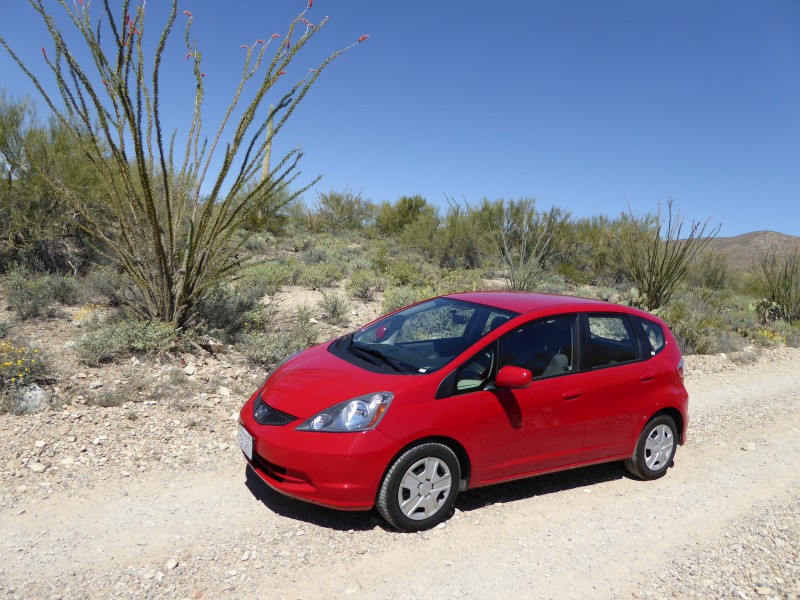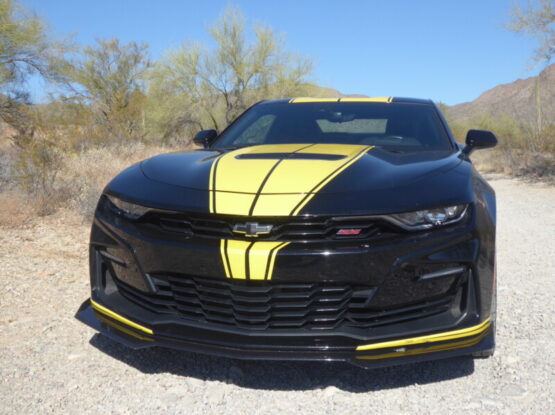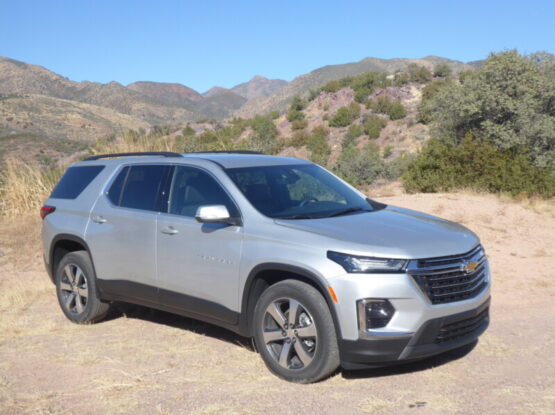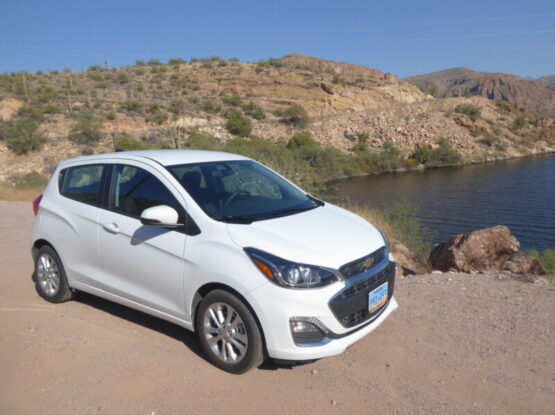








































Those who are unfamiliar with the finer details of the US market, but who are well versed in matters European, will be looking at the accompanying pictures and trying to figure out if this is simply a Jazz with a different name. The answer is “not quite”. Apart from variations in engine and transmission as well as trim and equipment, the key alteration for the US market is a significantly longer front overhang, intended to improve crash performance in accordance with NHTSA safety standards and testing. At a quick glance, you probably would not tell a US market Fit apart from a European spec Jazz, but put pictures of the two alongside each other and the difference is obvious. Even with the added inches, the Fit it still a small car, but Honda took the decision to add the model its range even during the life of the first, and much acclaimed model generation, as a replacement for the Civic hatch which had grown to the extent that it was officially classified as a Compact. The Fit, or Jazz, was first launched in 2001 and went on, the following year, to become the best-selling car in its native Japanese market, scooping up the Japanese Car of the Year award in the process. It was equally well received in Europe, where it adopted the Jazz name, and was added to the Honda range in many other countries around the world. Sales took off, and with the car made in 10 different plants in 8 countries, it did not take long for production to pass the million mark. By the end of 2010, over 3.5 million had been sold and by the end of 2013, the 5 million landmark was passed. A careful evolution of the first, the second generation Fit was premiered in Japan in October 2007, going on sale immediately. Once again, it was accoladed as Japanese Car of the Year. Slightly longer and wider than its predecessor, and with a much stiffer chassis, the second generation car took all the good points from its predecessor, notably its spaciousness and versatility, and aimed to improve on the weaknesses, of which ride comfort was the one most often singled out, and added new equipment features. It took a while before the model reached other markets. Americans first saw the new version at the New York Auto Show in March 2008, and were able to buy the car as a 2009 model year car from the end of August that year, which was slightly ahead of the European launch schedule of late 2008. At the time, the Fit was the most expensive car in its class, a problem caused to some extent by the fact that Fits are made in Japan, and the strength of that currency in the immediate post Credit Crunch era made Japanese made products appear expensive. However, the car was well received, and it was quickly recognised for excellence by the likes of Consumer Reports, who declared it to be the best vehicle in its class. During its life time, a number of additional features were added to the specification sheet, but otherwise the US market Fit models did not change much until they were replaced by the third generation car which went on sale in the summer of 2014 as a 2015 model year car.
Unlike the European spec cars where the initial choice of 1.2 or 1.4 litre petrol engines was augmented by a Hybrid model in 2012, American buyers got their Fit with a 1.5 litre 4 cylinder petrol engine, and only had to choose between a 5 speed manual or automatic transmission and Normal or Sport trim. That was it, apart from a limited program of all-electric Fit EV models that were leased out in California and Oregon. As this was a rental car, it came with the auto box and it was not the Sport model. First impression on heading out of the rental car facility and accelerating down the road was that this car is noisy. That impression, fortunately, subsided the following day when I took it south down the 10 freeway to Tucson, as at cruising speed, the noise abates somewhat meaning that the car is a pleasant enough companion at freeway speeds (75mph on that section of well-policed freeway). The engine is willing and it is smooth, but you do have to rev it reasonably hard to get traffic-compatible levels of acceleration. The gears are well spaced, but that does mean that you will build up quite a lot of revs before the transmission finds the next ratio. I could have sworn that there were only 4 speeds in the box, but the spec sheet says 5. I think that is because 5th is a real cruising ratio, which is also why the noise levels drop once you have reached a steady speed. This is an “old school” type gearbox, though, with no manual over-ride or flappy paddles, just a traditional PRND type lever which you pull back progressively depending on what you want to select. So, fast enough to keep up with the traffic, but no ball of fire, very much like many of its rivals. The road from Phoenix to Tucson is more or less completely flat, so I did not get to test the hill-climbing performance of the Fit, but I can well imagine that this will be a bit of an effort and the noise will return.
The flip side of all this comes at the pump. One of the very limited number of displays above the odometer in the bottom of the speedo is a little bar chart showing current fuel consumption, although as is often the way of these instantaneous readings where they fluctuate wildly, the bars were pretty consistently on or around 40. When I put just 6.25 gallons into the car having driven it 261 miles, the calculator tells me that this is 41.76 mpg US or 49.89 mpg Imperial, a very creditable figure indeed. The gauge was showing just on half empty, so you’d have a pretty decent range of around 500 miles, too. Honda cars were usually rather more interesting to drive than the rival Toyota and Nissan products and although some of their recent offerings have narrowed this gap (the latest US market Civic being an unfortunate case in point, being very anodyne compared to its predecessors), that still holds broadly true for this one. The steering is well weighted, with plenty of feel, and the handling was good. Not quite Fiesta style good in either respect, but certainly above average for the class. Even with a taller body than some of its competitors, this is a car that you can take on twisty roads without any apprehension, knowing that you will enjoy yourself at least a bit. There’s nowhere near enough power, or for that matter, grip from the Falken tyres on the standard 15″ wheels for you to get too excited, or for that matter to get into trouble, but it is enough for you not to regret taking the bendy way home. The Fit seemed to ride decently well, too, suggesting that the much stiffer chassis and the suspension tweaks made to this model compared to its predecessor could just have made a difference. The first bit of travel on the brake pedal felt a bit mushy but thereafter firmer pressure brought the little Honda to a stop cleanly and efficiently., There is a conventional pull-up handbrake fitted between the seats. One thing that did strike me as soon as I drove the Fit in daylight is just how airy the cabin is. A relatively low window line, by modern standards, at least, and a generous glass area, including large and welcome front quarter lights also mean that all round visibility is excellent. Of course you can’t see anything of the sloping nose, but you do know that it is not far in front of you. Coupled with a good view from the door mirrors, this made the Honda easy to park and manoeuvre as well as when fighting for a place among traffic.
The interior of the Fit is not going to win any prizes for the quality of its materials. But nor does it feel anything like as low-rent as cars in this class tended to do until very recently. The massive dash moulding is made of relatively hard black plastic and there is a fairly sizeable inlay in a sort of gunmetal colour which does at least provide some visual relief. The large glass area helps, so this does not feel at all sombre or gloomy, but nor does it feel anything other than kind of “fit for purpose” (oops – no pun intended!). It is certainly functional, with a simple cowl covering the instruments. A central speedo is flanked by dials with their own deep cowls, the left hand of which is the rev counter and the right hand contains a fuel gauge and a display area illuminating the gear selection you have made. The instruments are simple, big and clear and have bright blue markings at key intervals around their perimeter. The base of the speedo contains the digital odometer and a line which can show trip miles, fuel range or fuel consumption, and that is it. Chunky column stalks operate the indicators and lights from the left of the wheel and wipers from the right. In the centre of the dash, three rotary knobs for the air conditioning system are stacked in a vertical diagonal grouping down the side nearest the driver, leaving space in the middle for the audio unit which has pleasingly large buttons well spaced out to operate it. There are no repeater functions on the wheel for this unit, so you need to be able to operate it easily from here. That’s more or less it, a complete contrast from the over-stylised inside of a Fiesta or the button fest that you get in larger cars these days.
Where the Fit really scores is for its roominess. Some of that is created by virtue of mounting the fuel tank in the centre of the car, under the front seats. What that means is that front seat occupants do sit quite high up, and there is no height adjuster on the seat. Combine that with a steering wheel which even at its highest setting was still rather low, and there was an unusual driving position, reminiscent a bit of the latest Peugeots, though without their feature of the dinner-plate sized steering wheel. I was unsure at first whether I would find it comfortable, but by the time I had been in and out of the Fit a couple of times, it seemed perfectly OK to me. The seat has manual adjusters just for fore/aft and backrest angle, but despite this, I was still able to get comfortable. Seat material is a sort of almost velour like cloth which was quite pleasant to the touch and a bit nicer than some of the very cheap fabrics you sometimes find in other cars these days.
Those in the back of the Fit get a very good deal indeed. For such a small car, there is an amazing amount of space. The floor is almost flat, and thanks to the tall roofline and the fact that you sit reasonably upright – though the backrest angle of the seat can be altered through a few degrees, there is more room than you would normally find in a car of this class and size. Legroom is more than adequate even with the front seat set well back, and there would appear to be just about enough width to squeeze three adults across the rear seat. The boot is a good size, too. The floor area is generous and it is deeper than average from window line to boot floor. The rear seats are asymmetrically split, and as you push the backrest down, the rear seat cushions comes forward a bit, so that the result is a completely flat extension to the load area. There is a bit of room under the boot floor around the space saver spare. There is more space under the rear seat cushion even when the seats are in use, as they are mounted only at the rear point. Otherwise, rear seat occupants have a map pocket in the passenger seat back and bottle shaped bins on the doors. Up front, as well as door bins, there are lots of little cubby holes all over the place, including some lipped areas on the dash, and in front of the gearlever. There are two separate glove boxes, neither massive, but combined, a useful stowage area for odds and ends. There was an iPod connector cable hidden in the upper glovebox.
Unlike Canadian spec cars, there are only two trim levels of the US market Fit, the normal one and the Sport. When new, the premium for the Sport model was just under $2000, for which you got a ground appearance package, 16″ alloy wheels, paddle shifters, a security system, front fog lights, chrome exhaust finisher, a black finished dashboard with chrome accent highlights, a leather-wrapped steering wheel, steering wheel-mounted audio controls, carpeted floor mats, a 6-speaker AM/FM/CD audio system, and a manual mode on the automatic gearbox. Navigation was available as a cost option. Priced at $15,425 for a manual transmission car and $16,225 for an automatic, the normal spec car covers all the basics and nothing more, really. For sure it has ABS, traction control, side airbags, body coloured door mirrors, an alarm and vehicle anti-theft system, cruise control, all-round electric windows, a 4 speaker AM/FM Radio Audio System with CD, MP3, AUX and Bluetooth, air conditioning and that was about it, with 15″ wheels with plastic covers an easy identification point. Even things like a rear parcel shelf cost extra. One of the criticisms of this version of the Fit towards the end of its production life was that some of the equipment that even comes on standard on rivals such as the Chevrolet Sonic was not even available as an option on the Fit. That is something addressed by the third generation, 2015 model.
There was much to like about the Fit. Its roominess and versatility is without doubt at the very top of the class, so if this what you really want in a small car, it absolutely should be at the top of the shopping list. If, however, you are simply looking for a small supermini, or what Americans know as a sub-compact, good though the Fit is, I don’t think it’s the car I would choose. The Sonic is that bit better equipped and finished inside, and is pretty good to drive, and I am sure that the US spec Fiesta retains all the advantages of Ford’s popular small car, but for a car which ticks the “good to drive” and has no significant weakness, apart perhaps from being a touch noisy. I’d go for a Mazda 2. A new version of that is about to hit the streets, Honda’s new Fit is already out there, along with a revised Yaris with a goofy front-end, as well as the established Nissan Note, and for those who want a versatile small car, Kia’s funky Soul is a very strong contender, so things could all change in the battle of this class of car for 2015.










































































































